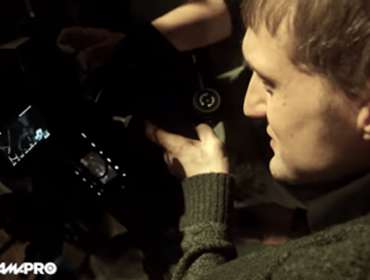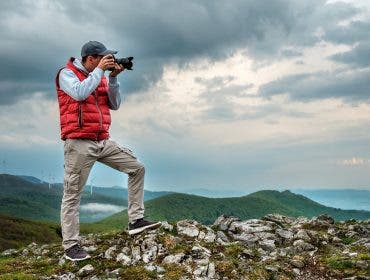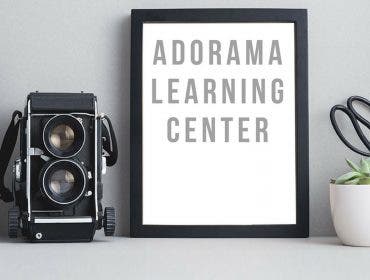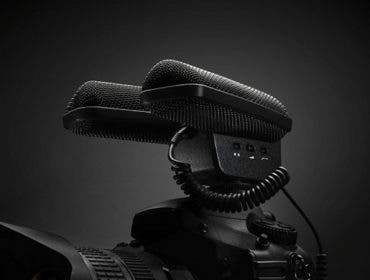Category-Leading Big-Sensor Compact Also Captures 4K Video
February 24, 2015
The retro-designed Panasonic LX100 is the first self-contained compact digital camera with a Micro Four Thirds sensor. The results are impressive.

Buying a compact digital camera usually involves a compromise regarding image quality, since most such cameras have smaller sensors. This is slowly starting to change, however, and the Panasonic Lumix DMC-LX100, the first Four Thirds sensor-based camera with a built-in lens, promises better resolution at higher speeds, combined with the responsiveness that Panasonic compacts are known for, a traditional control layout, and the ability to capture up to 4K video. It was an exciting camera to initially report about when it was announced last year, and has become very popular in a short time.
Featuring a 16MP Four Thirds CMOS sensor (actual measurement: 17.3x13mm), a fast 24-75mm (35mm equivalent) f/1.7-2.8 zoom lens, a top ISO of 25,600, the world’s highest resolution eye-level EVF (2,764 dots), and a choice of full auto or manual exposure and focus control dials and rings, the LX100 is a versatile little camera. Even better: Thanks to built-in Wi-Fi and NFC connectivity, you can immediately share your favorite photos and videos via your smart phone or tablet.
Can the LX100 fit in as a fast little street camera that delivers excellent images while offering enough art filters, automation and rich features to make it a vesatle shooter that will appeal to a wide range of discerning photographers? I had the opportunity to test it out in the lab and on the field; here’s what I found out.

In the hands
The LX100 is small, light, and unobtrusive, all great attributes for candid photography. A protruding grip gives users just enough purchase to handhold the camera with confidence, while a thumb rest in the back of the camera adds to comfortable operation. Top-of-camera dials and buttons are easy to access and operate. Lens aperture detents well-defined so you can set aperture by feel if you count off the clicks. The shutter speed and EV dials offer enough resistance that they are unlikely to be moved accidentally.
While the lens rings and camera top control dials hearken back to pre-digital camera design that is all the rage these days, the camera back controls are more typical of a compact digital camera, with the usual array of chicklet-type buttons, four-way toggle switch and surrounding ring for menu navigation.
While the 3-inch LCD monitor is quite good (although it doesn’t flip out and isn’t a touch screen, both minor quibbles), the eye-level electronic viewfinder is spectacular. It is located right where it should be, on the camera back’s upper left corner. If you’re right eyed, you can use the right eye to compose the image while scanning the scene with your left eye (it takes practice but is a very helpful tool for street shooters). To my eyes, the projected image was the closest to optical that I’ve seen to date. There were no artifacts in average light and minimal ones in low light, with no issues when panning the camera back and forth. The finder offers the full information screen and menu viewing you’d come to expect from an EVF.
The camera lacks a built-in flash, although a small flash that fits in the hot shoe is included in the kit. The lack of built-in flash isn’t a major issue, since the most likely end-users will be more interested capturing images in natural light. If you want more flash power, however, Panasonic has a lineup of compatible shoe-mount flashesincluding the $227FL360L, which also has an LED light to illuminate videos. The lens has a 43mm filter ring, and I highly recommend investing in a Skylight filterto protect the front element from fingerprints, dust, and scratches.
The LX100 is small, but not pocket-sized. It will fit in a jacket pocket, but this is the kind of camera you want in your hands all the time. Overall, I found the LX100 to be well-balanced, very easy to hold and operate despite its diminutive size.
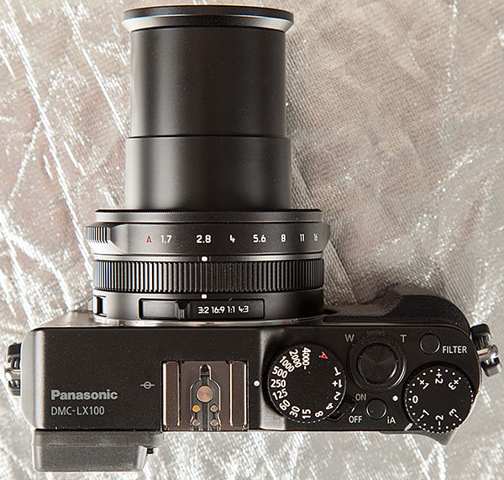
Controls and menus
The first thing that strikes me about the layout of the LX100 is that it was designed with traditionalists in mind. A familiar aperture ring, with a range of f/1.7 to f/16 in 1/3-stop click indents, surrounds the forward part of the lens base, while a focus ring is closer to the camera. Shutter speed is controlled via an old fashioned shutter speed dial atop the camera with a range of T and 1 to 4000 (you can go up to 1/16,000 sec electronically). A separate dial lets you control exposure to +/- 3 EV. ISO is set via a button on the four-way toggle switch on the camera’s back. A handy switch atop the lens barrel lets you select 3:2, 16:9, 1:1 or 4:3 aspect ratios. A switch on the left side of the lens base lets you change between manual, regular AF and Macro AF (which lets you focus up to the surface of the lens in its widest focal length).
Zooming is accomplished electronically via a rocker ring surrounding the shutter release. The 35mm equivalent focal length displays in the viewfinder as you are zooming, which is helpful information.
The Q Menu button gives you fast access to video resolution and frame rate controls, aspect ratio, image size and format, while the Filter button (located just to the right of the shutter release accesses art filters such as toy camera, high-contrast, selective focus and other modes that the Instagram crowd loves.

Instant reaction: When these gulls flew overhead, I was ready to catch the moment, and the LX100 responded with no hesitation.
In the Field
I immediately saw in the LX100 the possibility that it could be a great street photography camera. I switched to manual exposure and focus (which besides giving me more control, also cuts lag time to an absolute minimum). I also went to the Custom menu and put the camera on silent mode, so it would make absolutely no sound when I pressed the shutter release. Then I started shooting.
I found the camera to be extremely fast, with no apparent lag time, and was able to capture the decisive moment with ease. Focus peaking is helpful. When in manual focus there is a focus distance indicator, but it lacks any foot or meter measurement, something that has been a sore point for Panasonic users in general. Also, when in manual focus mode, the center of the image is enlarged as a focusing aid; when you’re done focusing, press the shutter release halfway to get the 100% view. The most practical way to use this feature on the street is to set focus in advance and work at that distance. All of these features do eat up power, and I recommend investing in a couple of additional batteriesso you’re not caught without power after a half a day of shooting.
When shooting autofocus mode, focus was impressively fast and decisive, even in lower light, right down to macro mode which focuses to just in front of the lens in the wide-angle setting and to about 10 inches at full telephoto. Shooting in aperture-priority is simple–turn the Shutter Speed wheel to “A” and turn the aperture ring. Want shutter priority? Reverse that, with the aperture ring on A while selecting the shutter speed. For full Autoexposure, turn both to A.
One interesting oddity: The LX100’s Leica DC Vario Summilux zoom lens has a variable widest aperture that changes as you zoom. How does that align with the aperture ring? If you’ve zoomed partly or all the way out, the largest aperture changes from f/1.7 to f/2.5. This will be indicated on the monitor, so if you’re zoomed beyond 28mm and you’ve set the lens to f/1.7, the on-screen aperture indicator is the accurate one.

Low light? No problem! Lab test results (see below) were typical for an APS sensor camera, but the large aperture lens made capturing images indoors in low light an easy task.
Image Quality
According to our test partner, DxOMark Labs, the Panasonic Lumix LX100 had an overall score of 67, putting it in a tie with its closest compeitor, the Sony Cyber-shot DSC-RX100 II. It is the highest-scoring self-contained compact camera, and ranks right in the middle of the pack compared to current interchangeable-lens cameras that use the same Four Thirds sensor format.
For all practical purposes, the highest ISO that we recommend if you want “clean” images would be ISO 400, but if you don’t mind a little digital noise, you can certainly get acceptable images at ISO 800 and 1600. Dynamic range is very good at up to 12.5EV, although it falls off to under 10 stops by ISO 1600 so keep that in mind when shooting high-contrast subjects.
Sample image quality photos: In this studio test sequence, I photographed Patient Patricia at all of the camera’s ISO settings, from 100-25600. Here are selected results showing 100% details, starting with a full-frame image of Patient Patricia at ISO 100.

Details of 100% blow-ups of the above at different ISOs:

ISO 200: No noise

ISO 800: A touch of digital noise starts to appear.
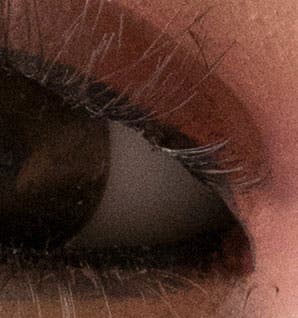
ISO 1600: Noise is a bit more apparent but still acceptable.

ISO 3200: Noise becomes more pronounced but image is still sharp

ISO 6400: Noise increases, loss of some detail.

ISO 25,000: No surprise here…very noisy with loss of detail overall.
Video
The Panasonic LX100 is quite possibly the smallest digital camera to record 4K, in MP4 format; it also records full HD in both MP4 and AVCHD Progressive formats in a variety of frame rates. Video quality was good, with acceptable noise even in low light.
Conclusion and recommendation
The Panasonic LX100 is a high-performance compact digital camera, with a fast-reacting shutter release, fast and decisive autofocus, and a rich feature set that will meet with the approval of traditionalists and modern camera enthusiasts alike. Its diminutive size, light weight make it an attractive option for travel photographers, although its limited focal range might be a factor against it. It’s a great choice for low-light photography and was outstanding in candid situations such as street photography, thanks to its fast shutter release and silent shooting mode. For those who want to dabble in high-quality video, the 4K video capture did an outstanding job, and can be easily cropped down to 1080p HD.
Yes, the LX100 is an expensive camera for a compact, but you get outstanding optics, image quality, and performance for such a a self-contained little body. It has an edge over its competition if you prefer traditiional manual shutter, aperture and focus control and is overall an excellent photographic tool. As of the time of this writing,Panasonic Lumix DMC-LX100is available at Adorama for $797.99.

